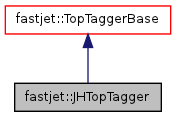|
FastJet 3.0.2
|
|
FastJet 3.0.2
|
Class that helps perform boosted top tagging using the "Johns Hopkins" method from arXiv:0806.0848 (Kaplan, Rehermann, Schwartz and Tweedie) More...
#include <fastjet/tools/JHTopTagger.hh>


Public Types | |
| typedef JHTopTaggerStructure | StructureType |
| the type of the associated structure | |
Public Member Functions | |
| JHTopTagger (const double delta_p=0.10, const double delta_r=0.19, double cos_theta_W_max=0.7, double mW=80.4) | |
| default ctor The parameters are the following: | |
| virtual std::string | description () const |
| returns a textual description of the tagger | |
| virtual PseudoJet | result (const PseudoJet &jet) const |
| runs the tagger on the given jet and returns the tagged PseudoJet if successful, or a PseudoJet==0 otherwise (standard access is through operator()). | |
Protected Member Functions | |
| std::vector< PseudoJet > | _split_once (const PseudoJet &jet_to_split, const PseudoJet &reference_jet) const |
| runs the Johns Hopkins decomposition procedure | |
Protected Attributes | |
| double | _delta_p |
| double | _delta_r |
| double | _cos_theta_W_max |
| double | _mW |
Static Protected Attributes | |
| static LimitedWarning | _warnings_nonca |
Class that helps perform boosted top tagging using the "Johns Hopkins" method from arXiv:0806.0848 (Kaplan, Rehermann, Schwartz and Tweedie)
The tagger proceeds as follows:
A JHTopTagger can be used as follows:
double delta_p = 0.10; // subjets must carry at least this fraction of the original jet's p_t double delta_r = 0.19; // subjets must be separated by at least this Manhattan distance double cos_theta_W_max = 0.7; // the maximal allowed value of the W helicity angle JHTopTagger top_tagger(delta_p, delta_r, cos_theta_W_max); // indicate the acceptable range of top, W masses (default: no limits) top_tagger.set_top_selector(SelectorMassRange(150,200)); top_tagger.set_W_selector (SelectorMassRange( 65, 95)); // now try and tag a jet PseudoJet top_candidate = top_tagger(jet); // jet should come from a Cambridge/Aachen clustering if (top_candidate != 0) { // successful tagging double top_mass = top_candidate.m(); double W_mass = top_candidate.structure_of<JHTopTagger>().W().m(); }
The full set of information available from the structure_of<JHTopTagger>() call is
The structure of the top_candidate can also be accessed through its pieces() function:
The W itself has two pieces (corresponding to W1, W2).
The existence of the first two of the structural calls (W(), non_W()) and the fact that the top is made of two pieces (W, non_W) are features that should be common to all taggers derived from TopTaggerBase.
See also 13 - boosted top tagging for a full usage example.
Definition at line 118 of file JHTopTagger.hh.
| fastjet::JHTopTagger::JHTopTagger | ( | const double | delta_p = 0.10, |
| const double | delta_r = 0.19, |
||
| double | cos_theta_W_max = 0.7, |
||
| double | mW = 80.4 |
||
| ) | [inline] |
default ctor The parameters are the following:
| delta_p | fractional pt cut imposed on the subjets (computed as a fraction of the original jet) |
| delta_r | minimal distance between 2 subjets (computed as |y1-y2|+|phi1-phi2|) |
| cos_theta_W_max | the maximal value for the polarisation angle of the W |
| mW | the W mass |
The default values of all these parameters are taken from arXiv:0806:0848
Definition at line 132 of file JHTopTagger.hh.
runs the tagger on the given jet and returns the tagged PseudoJet if successful, or a PseudoJet==0 otherwise (standard access is through operator()).
| jet | the PseudoJet to tag |
Implements fastjet::Transformer.
Definition at line 60 of file JHTopTagger.cc.
 1.7.4
1.7.4